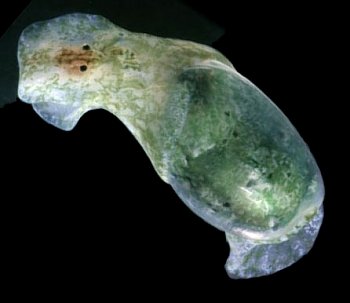
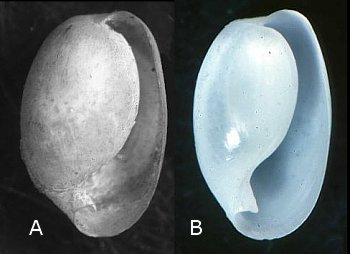
Diniatys dentifer
(A.Adams, 1850)
Order: CEPHALASPIDEA
Superfamily: HAMINOEOIDEA
Family: Haminoeidae
DISTRIBUTION
Tropical western Pacific.
PHOTO
UPPER: 5mm long; Tulamben, Bali, Indonesia, 2m; 21 May 1999 (bh06a). LOWER: A, Shell of Syntype, Bulla dentifera A.Adams, 1850; 5.1 x 3.4mm, BMNH #199406. Lord Hood's Island (Marutea Atoll, Tuamotu Archipelago) Type Locality. B, Shell 3.5 x 2mm, from 5mm specimen. Guam, Bile Bay reef flat (c30_2) 30 December 1987. Photos: C.H. Carlson & P.J. Hoff.
The genus Diniatys Iredale, 1936 [as a replacement for Dinia H & A Adams,
1854] is based upon shell alone. It's most distinguishing characteristic being a 'tooth-like' projection on the columella. The D. dentifer we have found are generally various shades of brown with a darker amorphous brown band on the midline of the head. Some have been found that are somewhat green in color and others without the band on the head.
The major host is the blue-green algae, Lyngbya majuscula (in earlier notes we used Microcoleus lyngbyaceus). It has also been found on Schizothrix and Hormothamnion.
[This is a summary of the message from C. Carlson and P.J. Hoff - 9 Sept, 2000]
NOTE: See Richard Willan's message correcting spelling from D. dentifera.
Reference:
• Adams, A. (1850) Monograph of the family Bullidae. In Sowerby, G. Thesaurus Conchyliorum. Vol. 2, London, pp. 553-608, pls 119-125.
Carlson, C.H. & Hoff, P.J., 2000 (September 8) Diniatys dentifer (A.Adams, 1850). [In] Sea Slug Forum. Australian Museum, Sydney. Available from http://www.seaslugforum.net/find/dinident
Related messages
Spelling of Diniatys dentifer
September 18, 2000
From: Richard Willan
Bill,
The generic name Atys was deemed to be masculine in Opinion 1553 (1989) of the
International Commission on Zoological Nomenclature (see Marshall & Willan 1999: 25). It follows that genera incorporating this name as a suffix must be masculine too. In other words, the correct spelling must be dentifer in the combination Diniatys dentifer (A. Adams, 1850).
Cheers,
Richard
Richard.Willan@nt.gov.au
Willan, R., 2000 (Sep 18) Spelling of Diniatys dentifer. [Message in] Sea Slug Forum. Australian Museum, Sydney. Available from http://www.seaslugforum.net/find/3035Dear Richard,
Thanks for letting us know. I must say that retaining the rquirement to alter species names to match gender, when species are moved from one genus to another, was one of the most unfortunate decisions made by the International Commission during the deliberations which preceded the adoption of the new International Code. There was a strong body of opinion in favour of fixing the spelling of species names so that they did not change. In precomputer days it was no big deal to look through an alphabetical list of names and find the ones you were looking for and any near matches. Now that we rely so heavily on databases and computer searching, changing names to meet the dictates of a dead language seem to me to be particularly ludicrous. While some search facilities can be customised to find 'near misses' this is not always the case. And for non-taxonomists who just want a stable name to use, this sort of pedantry gives nomenclature a very bad name, which I find hard, if not impossible, to justify.
Best wishes,
Bill Rudman.
Re: Liloa curta? from Samoa
September 9, 2000
From: Cory Pittman
Dear Bill,
Concerning Don's animal. I'd like to see the tooth-like projection at the base of the columella just to be sure but I think this is probably a large Diniatys dentifera (A. Adams, 1850). It's a good match for those I've seen in Hawaii.
Best wishes,
Cory Pittman
cory@cet.cet.com
Pittman, C., 2000 (Sep 9) Re: Liloa curta? from Samoa. [Message in] Sea Slug Forum. Australian Museum, Sydney. Available from http://www.seaslugforum.net/find/2969Thanks Cory,
Clay & Patty Jo have come to the same conclusion.
Bill Rudman.
Re: Liloa curta? from Samoa
September 9, 2000
From: Don Barclay
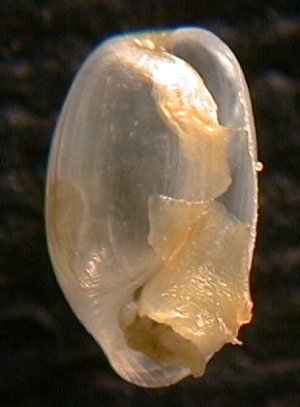
Dear Bill,
Here is a photo of the Liloa shell . Please pardon the animal interference, but I preserved the little fellow in straight ethanol and couldn't remove him for the photos.
Some sculpture is visible on the shell, but it is mostly smooth. There are wrinkles on the outer whorl where the shell curves in toward the spire, and there are several spiral striae on the anterior part of the shell. Other than that, the only thing I can see are a few growth striae.
Maybe these photos will help with the identification.
Cheers from Pago Pago,
Don
n5ols@samoatelco.com
Barclay, D., 2000 (Sep 9) Re: Liloa curta? from Samoa. [Message in] Sea Slug Forum. Australian Museum, Sydney. Available from http://www.seaslugforum.net/find/2993Dear Don,
I'm not sure from your photo whether I can see the characteristic 'tooth' of Diniatys dentifera, as described by Clay & Patty Jo and Cory Pittman, or whether I am looking at a bit of animal stuck at the vital place. Can you check for us?
Thanks,
Bill Rudman.
Re: 'Liloa curta' from Samoa
September 9, 2000
From: C. Carlson & P.J. Hoff


Don's Samoan haminoeid is what we are calling Diniatys dentifera (A.Adams, 1850). This is by far the most common haminoeid form in our collection. It is represented by records of over 800 specimens from Guam and the rest
of the Micronesian area--as well as others from the Philippines, Indonesia and PNG. The major host is the blue-green algae, Lyngbya majuscula (in earlier notes we used Microcoleus lyngbyaceus). It has also been found on Schizothrix and Hormothamnion.
The genus Diniatys Iredale, 1936 [as a replacement for Dinia H & A Adams,
1854] is based upon shell alone. It's most distinguishing characteristic being a 'tooth-like' projection on the columella. The D. dentifera we have found are generally various shades of brown with a darker amorphous brown band on the midline of the head. Some have been found that are somewhat green in color and others without the band on the head. Adult forms found in Bali and Tinian have been smaller than those from Guam. Those from Guam smaller than Palauan specimens. All of those checked have had almost the same shell shape, radula, gizzard plates, jaw elements and gross morphology of the male genital system.
UPPER PHOTO: 5mm long; Tulamben, Bali, Indonesia, 2m; 21 May 1999 (bh06a). LOWER: A, Shell of Syntype, Bulla dentifera A.Adams, 1850; 5.1 x 3.4mm, BMNH #199406. Lord Hood's Island (Marutea Atoll, Tuamotu Archipelago) Type Locality. B, Shell 3.5 x 2mm, from 5mm specimen. Guam, Bile Bay reef flat (c30_2) 30 December 1987. Photos: C.H. Carlson & P.J. Hoff.
Clay & Patty Jo
clay.carlson@kuentos.guam.net
Carlson, C.H. & Hoff, P.J., 2000 (Sep 9) Re: 'Liloa curta' from Samoa. [Message in] Sea Slug Forum. Australian Museum, Sydney. Available from http://www.seaslugforum.net/find/2997Dear Clay & Patty Jo,
Your reply certainly reinforces the pont I made in my repy to Don about the taxonomy of the shells being divorced from the animals in these 'bubble shells'. Diniatys dentifera is well-known to me from tropical Australia - as a shell, but I certainly didn't recognise it as an animal.
Best wishes,
Bill Rudman.
Liloa curta? from Samoa
September 5, 2000
From: Don Barclay
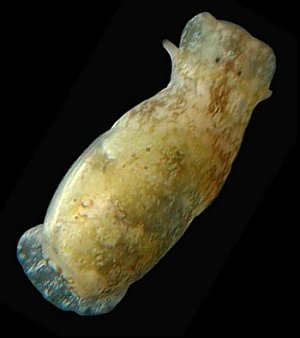
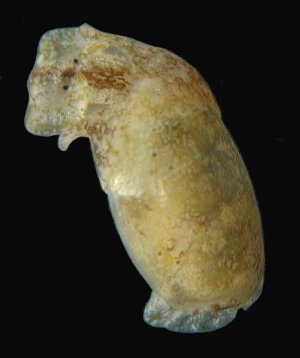
Dear Bill (and Clay and Patty Jo),
Here's a little haminoeid I collected today that I can't positively identify. It looks fairly similar to your photos of Liloa curta, except that the shell appears to be more inflated and smoothly curved instead of almost cylindrical. I can also clearly see striations on the shell of the animal on your Liloa curta page, but I can't see any on the one I collected, except possibly a single line about a third of the way back from the head.
Collected 1 September 2000, 1530 local time, low tide, under a mossy slab just off the beach on reef flat with scattered sand areas, near a freshwater seep in less than one meter of water.
Amanave village, American Samoa.
Shell measured 6.2mm, extended animal approximately 10mm.
Your opinion appreciated, as always!
Cheers,
Don
n5ols@samoatelco.com
Barclay, D., 2000 (Sep 5) Liloa curta? from Samoa. [Message in] Sea Slug Forum. Australian Museum, Sydney. Available from http://www.seaslugforum.net/find/2962Dear Don,
Bubble shells are quite difficult to identify from live animal photos because most were originally described from dead shells. The shells are often difficult to tell apart, with little sculpturing, and often animals from quite different families can have almost identically shaped shells.
That is not to say I don't want live animal photos - of course I do. It just would have been a lot easier for us, if we could ignore names based on empty shells. If it can be identified from photos of the animal, Clay & Patty Jo are the most likely people to be able to do it.
Best wishes,
Bill Rudman.
